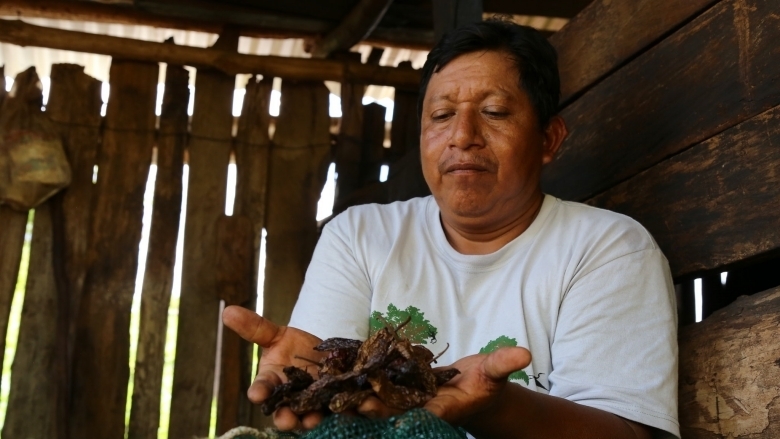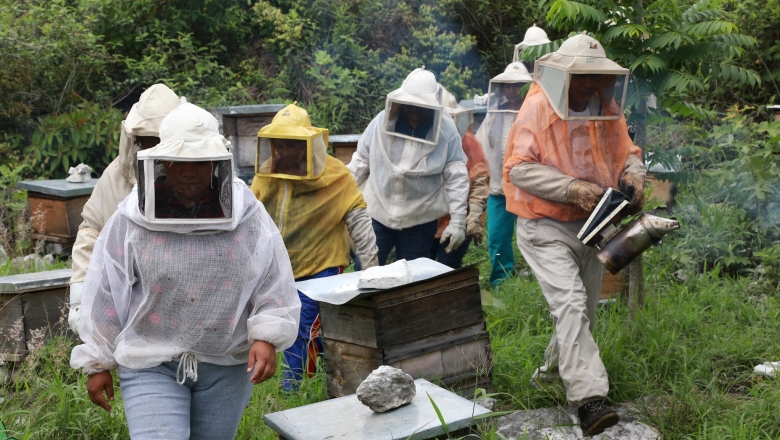Challenge
Mexico was classified as one of the top five most megadiverse countries, representing 12 percent of global biodiversity in just 1.5 percent of global land surface. Mexico’s Mesoamerican Biological Corridor, consisting of some of the country’s southern states, is considered a global biodiversity hotspot that provides habitat for many species either threatened or at risk of extinction.
In 2012, a top government priority was to align agricultural production and environmental conservation objectives. Scope had been demonstrated for working with producers to help reduce fragmentation of habitats, increase socioeconomic connectivity, and ensure long-term sustainability of productive landscapes. Roughly 70 percent of forests belonged to rural communities lacking access to markets and with insufficient knowledge and capacity related to drivers of deforestation and land degradation. About 50 percent of Mexico’s land was under agricultural production, and over half of all species were found in productive landscapes.
Approach
The (SPSB) aimed to conserve and protect nationally and globally significant biodiversity in Mexico by mainstreaming biodiversity friendly management practices in productive landscapes in priority biological corridors. To this end, technical groups provided trainings and technical assistance to participating producer associations and their linked producer groups. Associations also received matching grants for approved business plans to finance investments in subprojects, including the adoption of biodiversity friendly (amigables con biodiversidad AB) practices and/or processing of AB good and services.
Additionally, Technology Transfer Units (UTTs) were established to conduct research, development, and innovation in sustainable production practices, with one UTT for each productive system, transferring knowledge to technical service providers responsible in turn for building producer associations’ capacity. The project also fostered business alliances between buyers and associations for bio-labeled products, including establishing AB product standards for the design and use of market differentiation tools and for third-party verification of forestry, coffee, honey, and cocoa bio-labels. Efforts to promote collaboration and knowledge sharing across institutions in the Mesoamerican Biological Corridor countries (including Belize, Costa Rica, El Salvador, Guatemala, Honduras, some of Mexico’s southern states, and Nicaragua) contributed to the development of a Mesoamerican regional program for sustainable rural production.
Results
Between August 2012 and April 2019, the program achieved the following results:
• 81,462 hectares of land were brought into productive landscapes under AB production.
• 182 producer groups participated in AB business plans, and 12,956 producers applied AB production practices.
• Six differentiated bio-label instruments were developed, responding to positive market demand and consumers’ willingness to pay more for products with AB attributes.
• Approximately 42 business-buyer alliances were established for marketing differentiated products.
• As of April 2019, 24.4 percent of all sales were for products produced under AB practices; cacao, coffee, and honey reported the highest gains as they had better market opportunities.
• 51 targeted subareas (classified by vegetation types, habitat types, and species) within territories of the project received high-level biodiversity monitoring, and five pilot producer associations (communities) received equipment and trainings for mammal (including jaguar) and avian monitoring, a first for Mexico in terms of biodiversity monitoring.
In addition, an exhibition at the Museum of Sciences at Universidad Nacional Autonoma de Mexico was held from November 2018 to April 2019, reaching 60,000 visitors, including school children, university students, and many other groups (https://www.universum.unam.mx/exposiciones/t/producir-conservando). The exhibit demonstrated how the project developed AB practices in Mexican communities, and it informed the wider public on the value of knowledge about and conservation of national biocultural diversity and on practices and productive activities constituting viable options for promoting sustainable development.
Bank Group Contribution
The World Bank, through the International Bank for Reconstruction and Development (IBRD), administered a grant totaling US$ 10.8 million from the Global Environment Facility (GEF) to finance this project.
Partners
The project followed up previous operations of the Bank in Mexico, initiated in 1996, focused on mainstreaming biodiversity conservation in productive landscapes. In addition to the IBRD contribution, other project financing included US$ 7.18 million from the Government of Mexico and private sector financing from (i) Fomento Social Banamex (approximately US$ 1 million); and (ii) the Financial Institution for Rural Financing (Financiando el Desarrollo Del Campo, FINDECA) (US$ 1.63 million).
The experience, capacity, and commitment of the implementing agency, the National Commission for the Knowledge and Use of Biodiversity (The Comisión Nacional para el Conocimiento y Uso de la Biodiversidad, were key factors in the project’s success, as was the partnership between the Bank, the GEF, and government entities, including the Ministry of Environment and Natural Resources (Secretaría del Medio Ambiente y Recursos Naturales), the Ministry of Agriculture and Rural Development (Secretaría de Agricultura y Desarrollo Rural), and others. The private financing provided by Fomento Social Banamex and FINDECA was also critical to enabling the Producer Associations to obtain credit.
Beneficiaries
The project had a positive impact on public and private entities working to protect biodiversity throughout the Mesoamerican Corridor. Smallholder producers, primarily rural communities, including women and Indigenous Peoples, particularly benefited, as their establishment of AB business plans and investments in AB practices translated to higher profits for their products and/or services. More than 10,000 producers completed at least one training program on AB practices, and pilot communities gained knowledge and equipment required to monitor biodiversity.
Moving Forward
The objectives of the project remain aligned with Mexico’s National Biodiversity Strategy on “productive use and sustainable management” and its Action Plan 2016–2030. Several recently approved Bank-financed projects, including the Sustainable Productive Landscapes Project (approved March 30, 2018) and the Strengthening Entrepreneurship in Productive Forest Landscapes Project (approved January 28, 2018), build on the SPSB’s goals of strengthening sustainable management of productive landscapes and increasing economic opportunities for rural producers in priority areas of Mexico. The Bank continues to play a key role in fostering integrated landscape management for sustainable rural economic development in Mexico.
Learn More
Sustainable Production Systems and Biodiversity (SPSB) Project (P121116)
Authors: Luz Berania Diaz and Ashwini Rekha.
Implementation Period: August 30, 2012 – December 31, 2018
Link to documents:
1. Booklet for the Temporary Exhibition “ Producir Conservando Biodiversidad y Comunidades Sostenibles” (November 23, 2018 – April 28, 2019)
2. Implementation and Completion Report (June 2019)
3. Power Point Presentation on SPSB. November 2015
Multimedia
- Jaguar’s video: Jaguar is a key species and its recognized presence is an indicator of habitat quality for biodiversity conservation.
- Multimedia for coffee, honey, ecotourism, forestry, cacao, fauna: (all testimonies and videos)
- Multimedia Coffee (Rebeca Testimony – Indigenous woman in Colombia)

